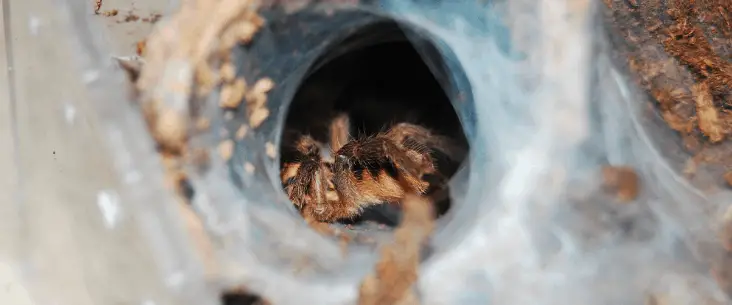One of the worst things that can happen in your tarantula enclosure is the growth of mould. Mould spores are bad for your tarantulas’ health, and mould is even known to kill your tarantula. Not even talking about how mould affects you as a keeper. Mould growth can happen by several factors, including high humidity enclosures, decaying bolus or decaying uneaten prey items. In nature, many creatures eat mould and decaying matters, like isopods and springtails. So, should we also put springtails in our tarantula enclosure as a clean-up crew?
Adding springtails to your tarantula enclosure decrease the risk of unwanted mould growth. Springtails will eat mould, fungi, algae, pollen and decaying matter. Many of these can become a problem in your tarantula enclosure, so springtails are highly beneficial to add to the substrate as a clean-up crew. However, keep in mind that some tarantulas don’t like (too many) crawlers under their feet.
What are the benefits of adding springtails to the substrate?
Springtails can make a valuable addition to a tarantula enclosure. Springtails are the enclosure cleaning dream team. These tiny little crawlers have many benefits for your enclosure.
The most important benefit of springtails is their appetite. And especially what they like to eat. Their favourite food is dead organic material and fungi (mould). It is their speciality to clean any enclosure of mould. With a healthy springtail cleanup crew, you should never have any problems with mould, because the springtails eat all.
Springtails also eat on dead organic matter and faeces, so it also helps you keep the enclosure clean. Springtails help create a natural decomposition cycle of all kinds of waste. Although, you still need to spot-clean the large chunks and don’t let uneaten prey items in the enclosure. Springtails also feed on bacteria that possibly grow in your enclosure.
What am I waiting for, let put in springtails you may think… Well, although springtails have many benefits, there are two main things you need to realize. The first is that not all tarantulas like a lot of springtails in their substrate. When the springtails are doing just too fine, it will crawl and cover your whole substrate floor. Second, springtails also need care, and when the substrate is kept too dry, or if there is not enough food, they won’t survive. Keep those things in mind.
How many springtails do you need at the start?
If you are convinced and want to add springtails to your tarantula enclosure, you may be asking how much springtails you need to add to make it successful. The answer is it depends, but at least not that much. It depends on how large the enclosure is and how fast you want you bioactive substrate to work.
For a typical tarantula enclosure (around 30cm x 30cm) that have fairly new/fresh substrate, you should add around 30 springtails, but even less will do. In the beginning, there is not much food, and the substrate needs to mature. If the circumstances are right, they will do perfectly fine and will reproduce.
If you start placing too many springtails, they may overpopulate the enclosure which is not comfortable for your tarantula. However, when you keep your enclosure a bit drier and when there is not much food available, they won’t reproduce or survive in the substrate (intentionally this can be a way to reduce the number of springtails in the enclosure). But, that would mean you also need to take care of the springtails, right?
Do springtails also need care in your tarantula enclosure?
Yes, just like every animal, springtails need also a certain amount of care to survive. Although, the amount of effort and care is almost neglectable if you have a proper substrate and proper substrate conditions.
First, you need to make attention to the humidity of your substrate. Many tarantulas do like slightly higher humidity than that is normal in houses. But springtails do absolutely need humidity to survive. So it is important that the substrate is always damp or that the lower layers of the substrate are moist. You can mist the enclosure once in a while to keep the humidity up — but, don’t spray directly on your tarantula. They absolutely don’t like to get wet. Tarantulas that are sprayed with water can react aggresive or move very fast and very sudden.
If you have enough ventilation in your enclosure, you won’t have that much mould spores, and when you have a substrate of mostly coconut fibre, there is also not much decaying matter for springtails to feed on. However, springtails do need a certain amount of food; otherwise, they won’t survive. In that case, it is not unwise to feed them one cricket leg once a while. When the substrate is already some older and more filled with detritus and faeces, you don’t have to feed your springtails anymore.
Want to know more?
Do you want to know more about keeping and caring for tarantulas? Head over to our page on caring for a pet tarantula and find all information about housing, feeding, cleaning and create the perfect habitat.
Share this page!



